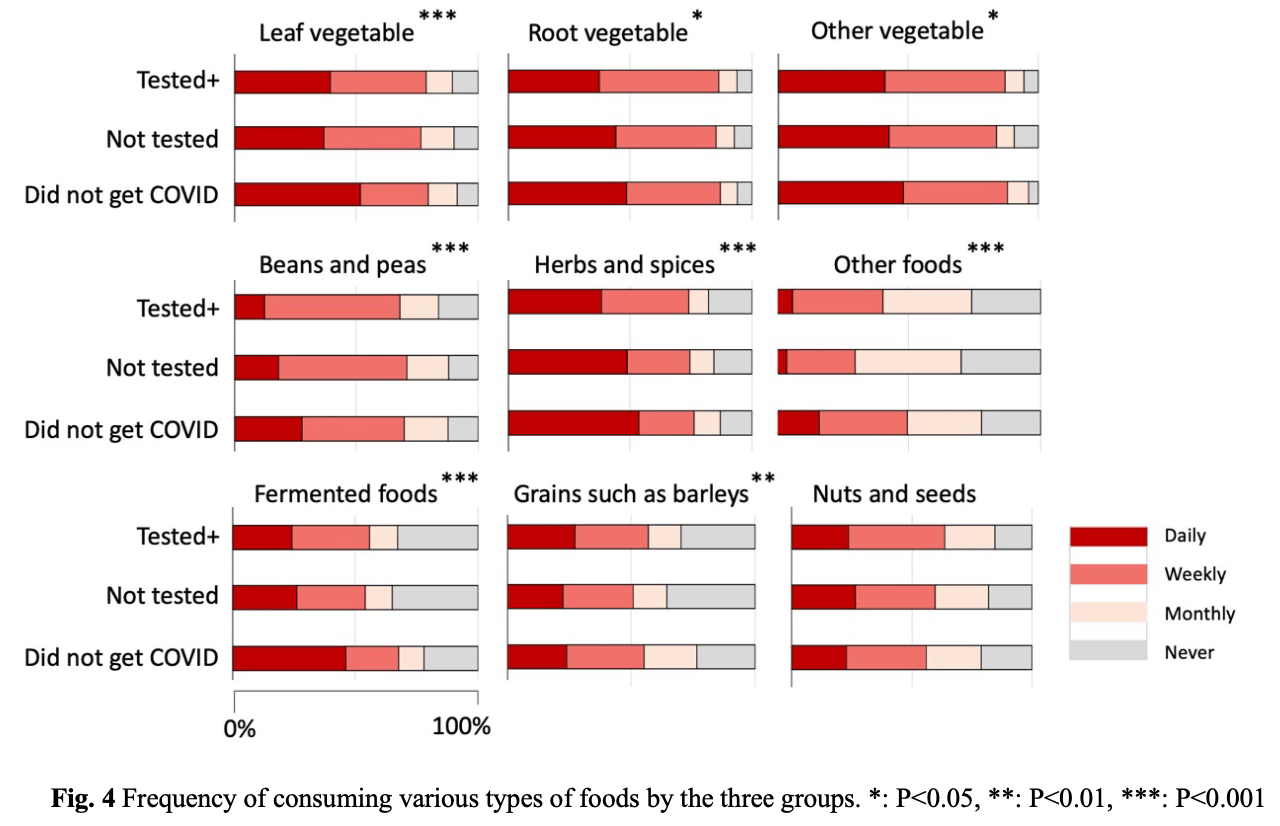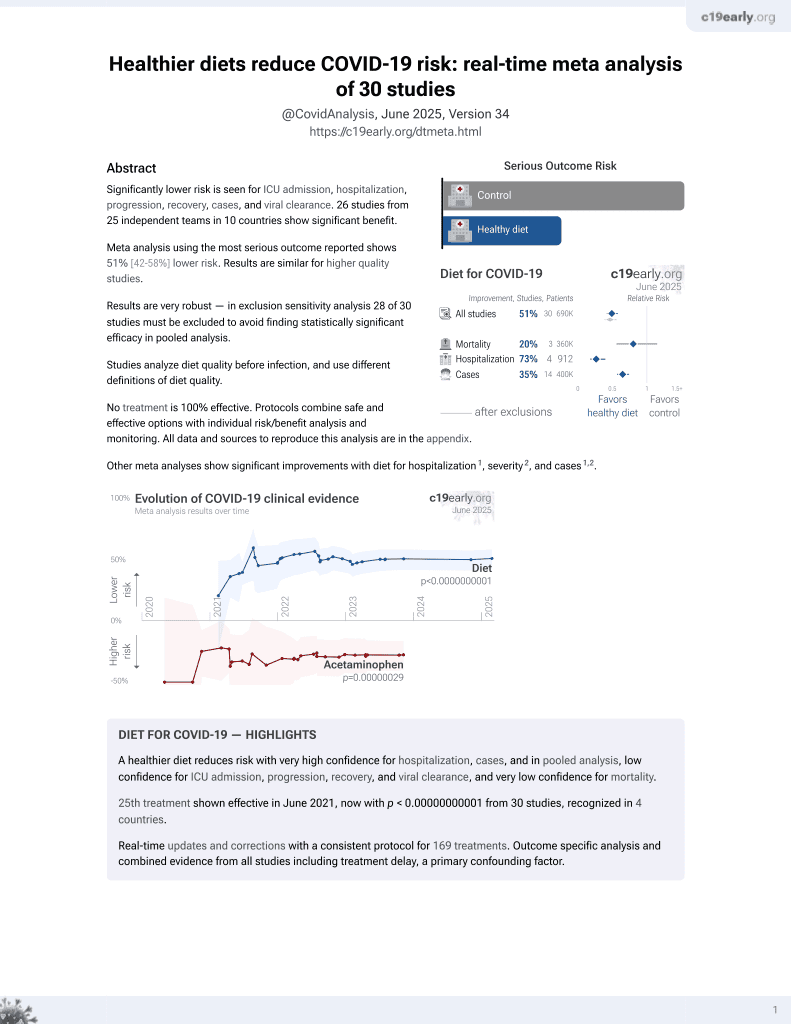
Possible roles of phytochemicals with bioactive properties in the prevention of and recovery from COVID-19
et al., medRxiv, doi:10.1101/2024.01.29.24301882, Jan 2024
Diet for COVID-19
26th treatment shown to reduce risk in
June 2021, now with p < 0.00000000001 from 30 studies, recognized in 4 countries.
No treatment is 100% effective. Protocols
combine treatments.
6,300+ studies for
210+ treatments. c19early.org
|
Survey of 1,583 participants globally showing higher daily intake of vegetables, herbs/spices, and fermented foods/beverages among those who did not contract COVID-19 compared to those who tested positive or suspected they had it. Shorter recovery times were self-reported in India and Japan regardless of testing status, associated with greater vegetable and fermented food intake.
Koyama et al., 30 Jan 2024, preprint, 28 authors.
Possible roles of phytochemicals with bioactive properties in the prevention of and recovery from COVID-19
doi:10.1101/2024.01.29.24301882
Purpose There have been large geographical differences in the infection and death rates of COVID-19. Foods and beverages containing high amounts of phytochemicals with bioactive properties were suggested to prevent contracting, to limit the severity of, and to facilitate recovery from COVID-19. The goal of our study was to determine the correlation of the type of foods/beverages people consumed and the risk reduction of contracting COVID-19 and the recovery from COVID-19.
Methods We developed an online survey that asked the participants whether they contracted COVID-19, their symptoms, time to recover, and their frequency of eating various types of foods/beverages. The survey was first developed in English and then translated into 10 different languages.
Results The participants who did not contract COVID-19 consumed vegetables, herbs/spices, and fermented foods/beverages significantly more than the participants who contracted COVID-19 and those who were not tested but became sick most likely from COVID-19. The geographic location of participants corresponded with the language of the survey, except for the English version, thus, nine out of the 10 language versions represented a country. Among the six countries (India, Iran, Italy, Japan, Russia, Spain) with over one hundred participants, we found that in India and Japan the people who contracted COVID-19 showed significantly shorter recovery time, and greater daily intake of vegetables, herbs/spices, and fermented foods/beverages was associated with faster recovery.
Conclusion Our results suggest that phytochemical compounds included in the vegetables may have contributed in not only preventing contraction of COVID-19, but also accelerating their recovery.
Author contributions SK, PVJ, VDCS, and TH served as the leadership team of the project to make decisions at each time points. All authors participated in developing the English version of the survey. The English version of the survey was translated into Chinese, Indian English, Italian, Japanese, Persian, Polish, Russian, Spanish, and Turkish, and the followings were in participated in the translation of each language: JC for Chinese, RisK and RitK for Indian English, CM-C and OC for Italian, RU and EM for Japanese, SP, RA, ZN, and FT-H for Persian, DJS for Polish, TKL, MAK, and VVV for Russian, MDG and PRD for Spanish, and EÖP and MHÖ for Turkish. All authors participated in advertising the survey. RisK, RitK, PA, HN, KWC, and SK analyzed the data. SK wrote the first draft of the paper and all authors participated in editing the draft. All authors read and approved the final manuscript.
Conflict of interest The authors have no conflicts of interest to declare
Ethics approval and consent to participate The survey contained a question that asked consent to participate and we obtained consent from the
Supplementary Information
Supplementary Methods
Development of Survey Questions about eating habits were constructed by asking how frequently the participants ate each category of foods, and the category was based on the food classification by the Ministry of Health Labour and Welfare of Japan..
References
Acosta-Navarro, Dias, Gouveia, Vegetarian and plant-based diets associated with lower incidence of COVID-19, BMJNPH e, doi:10.1136/bmjnph-2023-000629
Al-Sayyar, Hulme, Thibaut, Respiratory Tract Infections in Diabetes -Lessons From Tuberculosis and Influenza to Guide Understanding of COVID-19 Severity, Front Endocrinol, doi:10.3389/fendo.2022.919223
Bahun, Jukić, Oblak, Inhibition of the SARS-CoV-2 3CLpro main protease by plant polyphenols, Food Chem, doi:10.1016/j.foodchem.2021.131594
Balasubramanian, Maideen, Muthusamy, Role of Supplements in the Management of COVID-19 -A Comprehensive Review, Infect Disord Drug Targets, doi:10.2174/1871526523666230310094646
Ballester, Cerdá, Arcusa, Antioxidant Activity in Extracts from Zingiberaceae Family: Cardamom, Turmeric, and Ginger, Molecules, doi:10.3390/molecules28104024
Bousquet, Anto, Czarlewski, Cabbage and fermented vegetables: From death rate heterogeneity in countries to candidates for mitigation strategies of severe COVID-19, Allergy, doi:10.1111/all.14549
Bousquet, Czarlewski, Zuberbier, Spices to Control COVID-19 Symptoms: Yes, but Not Only…, Int Arch Allergy Immunol, doi:10.1159/000513538
Cappadona, Rimoldi, Paraboschi, Asselta, Genetic susceptibility to severe COVID-19, Infect Genet Evol, doi:10.1016/j.meegid.2023.105426
Chaudhary, Sreenivasulu, Mitra, Role of Genetic Variants and Gene Expression in the Susceptibility and Severity of COVID-19, Annals of laboratory medicine, doi:10.3343/alm.2021.41.2.129
Chourasia, Koppula, Battu, EGCG, a Green Tea Catechin, as a Potential Therapeutic Agent for Symptomatic and Asymptomatic SARS-CoV-2 Infection, Molecules, doi:10.3390/molecules26051200
Devaux, An update on angiotensin-converting enzyme 2 structure/functions, polymorphism, and duplicitous nature in the pathophysiology of coronavirus disease 2019: Implications for vascular and coagulation disease associated with severe acute respiratory syndrome coronavirus infection, Front Microbiol, doi:10.3389/fmicb.2022.1042200
Frere, Serafini, Pryce, SARS-CoV-2 infection in hamsters and humans results in lasting and unique systemic perturbations after recovery, Sci Transl Med, doi:10.1126/scitranslmed.abq3059
Ginting, Chiari, Duta, COVID-19 pandemic sheds a new research spotlight on antiviral potential of essential oils -A bibliometric study, Heliyon, doi:10.1016/j.heliyon.2023.e17703
Gupta, Singh, Varadwaj, Secondary metabolites from spice and herbs as potential multitarget inhibitors of SARS-CoV-2 proteins, Journal of Biomolecular Structure and Dynamics, doi:10.1080/07391102.2020.1837679
Haddad, Gaudreault, Sasseville, Molecular Interactions of Tannic Acid with Proteins Associated with SARS-CoV-2 Infectivity, IJMS, doi:10.3390/ijms23052643
Hosseini, Berthon, Saedisomeolia, Effects of fruit and vegetable consumption on inflammatory biomarkers and immune cell populations: a systematic literature review and meta-analysis, Am J Clin Nutr, doi:10.1093/ajcn/nqy082
Ishak, Mehendale, Alrawashdeh, The association of COVID-19 severity and susceptibility and genetic risk factors: A systematic review of the literature, Gene, doi:10.1016/j.gene.2022.146674
Jang, Park, Cha, Tea Polyphenols EGCG and Theaflavin Inhibit the Activity of SARS-CoV-2 3CL-Protease In Vitro, Evidence-Based Complementary and Alternative Medicine, doi:10.1155/2020/5630838
Jena, Kanungo, Nayak, Catechin and curcumin interact with S protein of SARS-CoV2 and ACE2 of human cell membrane: insights from computational studies, Sci Rep, doi:10.1038/s41598-021-81462-7
Kim, Rebholz, Hegde, Plant-based diets, pescatarian diets and COVID-19 severity: a population-based case-control study in six countries, BMJNPH, doi:10.1136/bmjnph-2021-000272
Korayem, Ahmed, Meabed, Genetic clues to COVID-19 severity: exploring the stromal cell-derived factor-1/CXCL12 rs2839693 polymorphism in adult Egyptians, BMC Infect Dis, doi:10.1186/s12879-023-08691-1
Koyama, Kondo, Ueha, Possible Use of Phytochemicals for Recovery from COVID-19-Induced Anosmia and Ageusia, IJMS, doi:10.3390/ijms22168912
Koyama, Purk, Kaur, Beta-caryophyllene enhances wound healing through multiple routes, PLoS ONE, doi:10.1371/journal.pone.0216104
Kulkarni, Nagarajan, Ramesh, Computational evaluation of major components from plant essential oils as potent inhibitors of SARS-CoV-2 spike protein, Journal of Molecular Structure, doi:10.1016/j.molstruc.2020.128823
Kumar, Kashyap, Chowdhury, Identification of phytochemicals as potential therapeutic agents that binds to Nsp15 protein target of coronavirus (SARS-CoV-2) that are capable of inhibiting virus replication, Phytomedicine, doi:10.1016/j.phymed.2020.153317
Landry, Ward, Cunanan, Cardiometabolic Effects of Omnivorous vs Vegan Diets in Identical Twins: A Randomized Clinical Trial, JAMA Netw Open, doi:10.1001/jamanetworkopen.2023.44457
Laponogov, Gonzalez, Shepherd, Network machine learning maps phytochemically rich "Hyperfoods" to fight COVID-19, Hum Genomics, doi:10.1186/s40246-020-00297-x
Merarchi, Dudha, Das, Garg, Natural products and phytochemicals as potential ANTI-SARS-COV -2 drugs, Phytotherapy Research, doi:10.1002/ptr.7151
Mokhtari, Azizi, Sheikhbahaei, Plant-Derived Antioxidants for Management of COVID-19: A Comprehensive Review of Molecular Mechanisms, Tanaffos
Muhialdin, Zawawi, Razis, Antiviral activity of fermented foods and their probiotics bacteria towards respiratory and alimentary tracts viruses, Food Control, doi:10.1016/j.foodcont.2021.108140
Nakashio, Ohgitani, Shin-Ya, Milk Casein Inhibits Effect of Black Tea Galloylated Theaflavins to Inactivate SARS-CoV-2 In Vitro, Bioengineering, doi:10.3390/bioengineering10091068
Nimer, Khabour, Swedan, Kofahi, Effect of natural products use prior to infection with COVID-19 on disease severity and hospitalization: A self-reported crosssectional survey study, F1000Res, doi:10.12688/f1000research.121933
Ohgitani, Shin-Ya, Ichitani, Significant Inactivation of SARS-CoV-2 In Vitro by a Green Tea Catechin, a Catechin-Derivative, and Black Tea Galloylated Theaflavins, Molecules, doi:10.3390/molecules26123572
Parma, Ohla, Veldhuizen, More Than Smell-COVID-19 Is Associated With Severe Impairment of Smell, Taste, and Chemesthesis, Chem Senses, doi:10.1093/chemse/bjaa041
Proal, Vanelzakker, Aleman, SARS-CoV-2 reservoir in post-acute sequelae of COVID-19 (PASC), Nat Immunol, doi:10.1038/s41590-023-01601-2
Shamsabadi, Nazer, Ghasemi, Promising influences of zingerone against natural and chemical toxins: A comprehensive and mechanistic review, Toxicon, doi:10.1016/j.toxicon.2023.107247
Shamsnia, Roustaei, Ahmadvand, Impact of curcumin on p38 MAPK: therapeutic implications, Inflammopharmacology, doi:10.1007/s10787-023-01265-2
Shi, Yang, You, Updates on the chemistry, processing characteristics, and utilization of tea flavonoids in last two decades (2001-2021), Critical Reviews in Food Science and Nutrition, doi:10.1080/10408398.2021.2007353
Shin-Ya, Nakashio, Ohgitani, Effects of tea, catechins and catechin derivatives on Omicron subvariants of SARS-CoV-2, Sci Rep, doi:10.1038/s41598-023-43563-3
Sidhwani, Mirza, Khatoon, Angiotensin-converting enzyme 2 (ACE2) polymorphisms and susceptibility of severe SARS-CoV-2 in a subset of Pakistani population, Virol J, doi:10.1186/s12985-023-02091-2
Steinmann, Buer, Pietschmann, Steinmann, Anti-infective properties of epigallocatechin-3-gallate (EGCG), a component of green tea: Anti-infective effects of EGCG, Br J Pharmacol, doi:10.1111/bph.12009
Subar, Thompson, Kipnis, Comparative Validation of the Block, Willett, and National Cancer Institute Food Frequency Questionnaires, American Journal of Epidemiology, doi:10.1093/aje/154.12.1089
Teli, Shah, Chhabria, In silico Screening of Natural Compounds as Potential Inhibitors of SARS-CoV-2 Main Protease and Spike RBD: Targets for COVID-19, Front Mol Biosci, doi:10.3389/fmolb.2020.599079
Vadgama, Kreymerman, Campbell, SARS-CoV-2 Susceptibility and ACE2 Gene Variations Within Diverse Ethnic Backgrounds, Front Genet, doi:10.3389/fgene.2022.888025
Vajargah, Zargarzadeh, Ebrahimzadeh, Association of fruits, vegetables, and fiber intake with COVID-19 severity and symptoms in hospitalized patients: A cross-sectional study, Front Nutr, doi:10.3389/fnut.2022.934568
Vu, Rydland, Achenbach, Dietary Behaviors and Incident COVID-19 in the UK Biobank, Nutrients, doi:10.3390/nu13062114
Wang, Kan, Thompson, Impact of Six Typical Processing Methods on the Chemical Composition of Tea Leaves Using a Single Camellia sinensis Cultivar, Longjing 43, J Agric Food Chem, doi:10.1021/acs.jafc.8b05140
Wong, Inflammation in COVID-19: from pathogenesis to treatment, Int J Clin Exp Pathol
Wu, Li, Peng, Coffee as a dietary strategy to prevent SARS-CoV-2 infection, Cell Biosci, doi:10.1186/s13578-023-01154-9
You, Dai, Zhong, Clinical evidence of three traditional Chinese medicine drugs and three herbal formulas for COVID-19: A systematic review and metaanalysis of the Chinese population, J Integr Med, doi:10.1016/j.joim.2023.08.001
